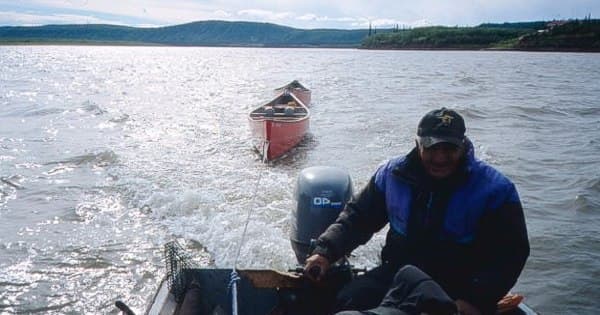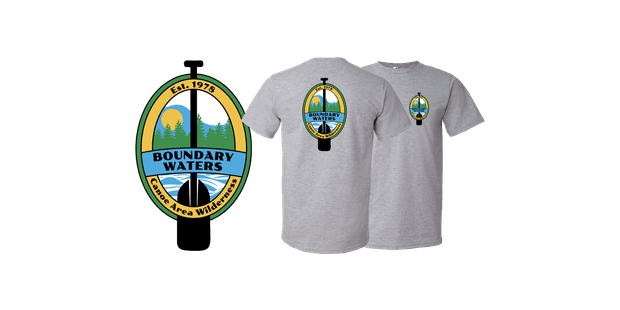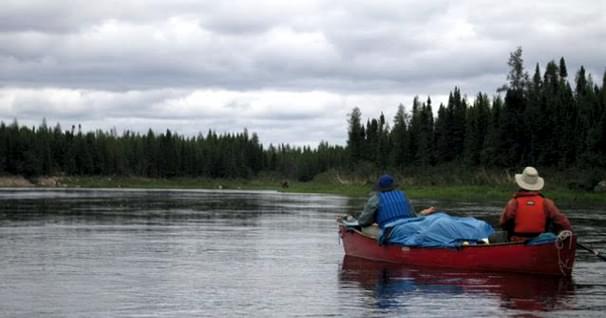Towing Canoes
What do you do if your canoe trip begins or ends with a long open water crossing? You can paddle the big water, of course, but it's time-consuming and possibly dangerous. A float plane is a safe (but expensive) option - and that's only if there's a suitable landing spot. On Hudson Bay and on many sprawling Canadian lakes, there isn't. The alternative is to charter a power boat to tow your canoe to a nearby village or fishing camp where there's road, rail or float plane access.

Canoeing texts make towing sound like a lark. It isn't. If a wind comes up, the pilot drives too fast, turns too fast or just doesn't know what he's doing, you've got big trouble. My first tow - 35 miles across Wollaston Lake, Saskatchewan - nearly ended in disaster. One canoe capsized and water poured over the transom of the boat and nearly sank it. Fortunately, we were able to make a protective cove and put things right. Seven subsequent tows have been problem-free, though not without trepidation.
Here's what I've learned over the years:
- The safest procedure is not to tow at all. Instead, tie your canoe or kayak to the deck of the power boat. However, this consumes space for passengers and gear and the canoe becomes a sail in wind.
- Tow empty! An aluminum fishing boat is the "tow boat" of choice in most of Canada. The pilot will often run two motors (for power and reliability) on a long haul and carry 15 to 20 gallons (120-160 pounds) of gas. Two passengers plus one canoe and gear are a full load on a 16-foot boat; four and two canoes will max out an 18-20 footer.
Some paddlers fill their canoe with gear, thinking this will free up passenger space in the power boat and make the canoe more stable when it's towed. *Wrong*!
~Get the BWCAW Tee~
With over 1,090,000 acres of wilderness area, the BWCAW is a paddler's paradise.
A heavily loaded canoe responds poorly to the pitch of waves and the wake of a power boat. It will plow and take on water as towing speeds rise, or when the lake gets rough. If a towed canoe capsizes, it may act as a sea anchor and swamp the tow boat from behind!
- Attach the tow line to a lining hole that's low on the stem of the canoe (use a bowline plus a stopper knot), or make a towing bridle (figure 1). Tie to the grab loop on kayaks. You can clip the tow rope to a far edge of the boat transom, or rig a Y-harness around the motor. Either method works fine.
- Tow one craft behind the other. Avoid parallel configurations which allow the canoes to cross lines and snag. Allow about 15 feet of space between each boat. I consider three canoes the limit for this arrangement. Weight the tow boat well forward.
- One person must watch the towed canoes at all times. The observer should have a ready knife so he or she can cut the tow rope quickly if an emergency develops.
- Canoeists should snap on their spray covers if they have them. Kayakers should secure skirts (close the waist hole).
- The tow boat will pound and take on spray and you'll chill fast. You'll want a stocking cap, hooded rain coat and gloves.
In summary:
1. Tow on board if you can. If not, tow empty and in tandem.
2. Attach the tow line to a lining hole near cutwater or rig a harness around each boat.
3. Carry a knife and watch the towed canoe(s).
4. Dress warm and for rain (boat spray).
Cliff Jacobson is a professional canoe guide and outfitter for the Science Museum of Minnesota, a wilderness canoeing consultant, and the author of more than a dozen top-selling books on camping and canoeing. www.cliffcanoe.com
Related Articles
Previously, I wrote about some perceived fears of first time wilderness canoeists. This time, I wanted…
In this video, wilderness adventurer Jim Baird documents his float plane ride into the wilderness to Lac…


